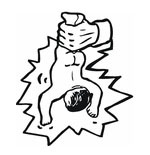
Dissecting the Partial-Birth Abortion Ban
WHAT WAS BANNED?
What is one to do, when faced with a yes or no decision that is morally appalling in both directions? For centuries, philosophers and ethicists have debated the notion of situation ethics, whereby they pose impossible scenarios involving a “this or that” choice in an attempt to discredit the idea of a moral absolute. The point of their argument is that, in some situations, one must choose the lesser of two evils. Forgetting that one must never choose evil at all, the five Catholics who sit on the Supreme Court of the United States faced such a decision this past April in their Gonzales v. Carhart decision.
Some background: The Partial-Birth Abortion Ban Act of 2003 was hailed by many in the prolife community, and lamented by those in the pro-death camp, as the beginning of the end of so-called abortion rights. The common belief was that the Act would be the launching pad for further legislative and legal measures that would eventually lead to an overturning of Roe v. Wade. Nothing could be further from the truth. Prolifers have been completely misled by what is at best lip service, but what is in reality a cementing affirmation of the precedent established by Roe.
The Act itself acknowledges the brutality of the partial-birth abortion procedure, whereby an infant is partially delivered and then murdered before he is fully born, stating that it is “a gruesome and inhumane procedure that is never medically necessary and should be prohibited” (Sec. 2.1). It then proceeds to present the evidence and supporting arguments that “a ban on partial-birth abortion is not required to contain a ‘health’ exception, because the facts indicate that a partial-birth abortion is never necessary to preserve the health of a woman, poses serious risks to a woman’s health, and lies outside the standard of medical care” (Sec. 2.13). Many prolifers see this Act as a means of upsetting “health of the mother” exceptions, but fail to realize that “health of the mother” clauses are not under attack, nor is legal precedent established against such clauses due to mere mention of them in the Act itself. Because the health of the mother has not been demonstrated to be a factor in partial-birth abortions whatsoever, the Act clearly established (later upheld by the Supreme Court) that there was no placement of undue burden on the mother, rendering the Act constitutional. As such, the exclusion of a “health of the mother” clause will not present any help in striking down other abortion procedures, but perpetuates the notion that if evidence can be presented that a given procedure is necessary in preserving a mother’s health, then a “health of the mother” exception shall be required.
You May Also Enjoy
The final scene of Infinity War is particularly haunting for millennials; a whole third of our generation has been destroyed by abortion.
The practice of abortion as a Satanic ritual is confirmed in a disturbing interview with a former leader of the Church of Satan.
Suggesting that the very young, born or preborn, are not persons is exclusivist. It makes the betrayal of children almost morally palatable.

